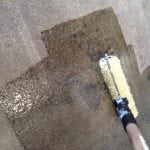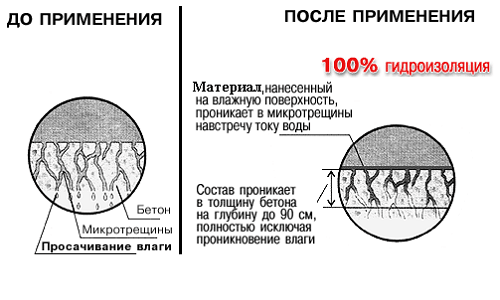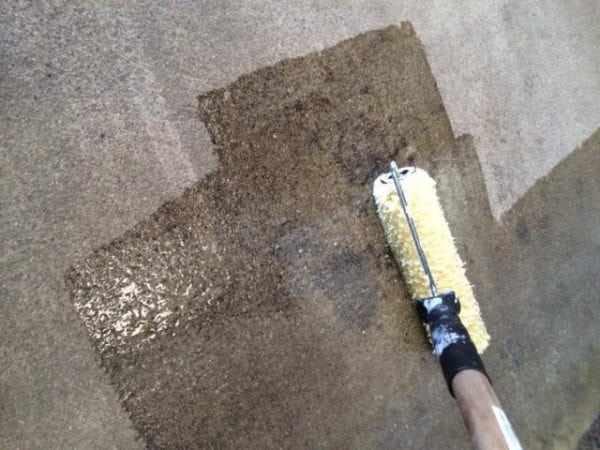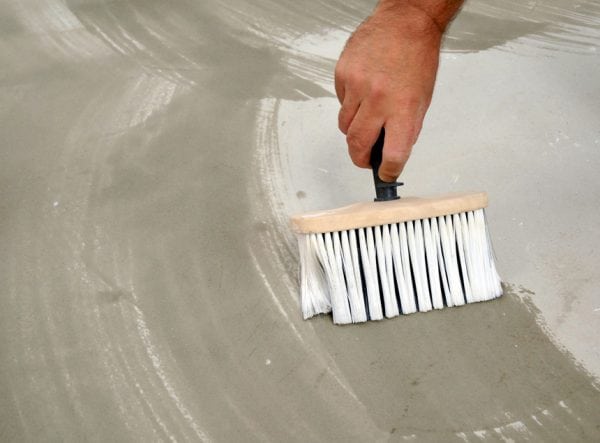Concrete primer - a material indispensable for finishing concrete surfaces. The primer performs many important tasks, ignoring which will not allow you to perform work at a high quality level.
- Functions of primers
- Classification of primers by composition
- Classification of primers according to the quality of the substrate
- Primer Selection Tips

Functions of primers
Products made of standard concrete are prone to gradual destruction and are subject to the influence of natural factors. The primer is largely able to prevent or slow down the influence of the external environment.
Features of primers:
- The soil ensures uniformity of the coating, as it penetrates into all, even minor, pores. The following finishing materials, including putty, varnish, paint, wallpaper, linoleum, etc., are easier to apply to the primed surface.
- Thanks to the primer, a normal level of adhesion (adhesion) between the materials is ensured.
- Primer for concrete makes the surface layer of material stronger. This does not mean that without it, concrete will necessarily fall off in pieces. However, even if the concrete begins to crumble, this will lead to peeling of the finishing materials.
- Soil protects the concrete surface from adverse environmental factors, including moisture, wind, chemicals, mold and fungus.
- The primer composition allows you to save on the consumption of material applied later (glue, varnish, paint, etc.). The reason for the savings is that the primer will fill all the pores and cracks.
- Primer for concrete not only prevents excessive wetting of the concrete, acting as a waterproofing, but also protects the material from excessive dryness.
Thus, in the finishing work the use of a primer is mandatory. Without priming, it is not possible to ensure proper repair quality.
to contents ↑Classification of primers by composition
The following are the characteristics of common types of primers:
- Polystyrene primers. These compounds are rarely used in everyday life. The fact is that such primers include toxic solvents. Polymer compositions are used in industrial premises or for facade decoration. Also, a polystyrene base is necessary for some specific types of paints. Usually polystyrene primers are applied to the plaster - under the tile or paint.
- The most common type of primer is based on an acrylic component. The advantages of acrylic compositions include the absence of a pungent odor, compatibility with any type of finishing materials, as well as excellent absorbency. As a rule, already 3-4 hours after concrete treatment, finishing work can begin. Eco-friendly acrylic allows you to use such primers for any room, including children's rooms. However, for external walls, acrylic is undesirable, since it dries too quickly.
- For quick decoration of the premises, polyvinyl acetate primers are used. They dry in half an hour. After that, to improve adhesion, the surface must be treated with PVA glue.
- Epoxy primers are based on resin. Most often used when working with bulk floors. They can significantly increase the wear resistance of the material.
- Alkyd soils are also in demand. They are applied to the concrete surface before painting.Alkides penetrate the pores and protect the concrete from moisture. The drying time of the surface is approximately 12-15 hours.

For the processing of aerated concrete, the best option is considered to be soils with polymer contents. Primers for aerated concrete not only protect the material from moisture, but also strengthen its structure.
to contents ↑Classification of primers according to the quality of the substrate
Primer compositions are also customary to distinguish based on the characteristics of the base, namely: its porosity and level of looseness. According to this indicator, primers can belong to one of three groups:

- Deep penetration primer for concrete with increased porosity. Moreover, there is not only a lot of pores in such concrete, they are also deep. Important note: the surface should not be too loose. Deep penetrating primers can penetrate approximately 5-7 millimeters deep into concrete. Such compositions are distinguished by increased adhesive capabilities, which is especially important in the presence of deep pores. Good adhesion is achieved thanks to latex particles that adhere the concrete surface to the finishing material.
- Impregnating soils are best used to protect old loose concrete (for example, for reconstruction purposes). Impregnation is also relevant for highly porous surfaces. The impregnating composition contains a special bonding element that holds together all small particles of material. The most expensive types of impregnation can strengthen the walls and screed, which were previously considered unsuitable for repair. In relation to impregnations, the principle applies: the more it is applied, the stronger the concrete structure will be.
- Adhesive primers are designed to create a special invisible film that will provide better adhesion to dissimilar materials. Adhesive formulations are especially relevant for very smooth concrete surfaces that have previously been putty or painted. It is also possible to apply an adhesive primer before plastering if the layer of plaster is not too thick.
to contents ↑Note! Depending on the condition of the coating, its porosity and roughness, the consumption of the primer may vary between 200 and 300 grams per 1 m2.
Primer Selection Tips
Below are recommendations for choosing a primer:
- Regardless of the type of primer, it is recommended to choose a composition with antiseptic properties. This will prevent moldy concrete. If the room will be operated in conditions of high humidity, you need to choose a primer with a high concentration of antiseptic.
- When buying soil, it is necessary to take into account the place of its use - outdoors or indoors. For exterior walls, it is recommended to use a facade primer. Its advantage is that it does not dry out too quickly, which is important for street conditions. For internal walls, you can use any type of soil.
- It is necessary to take into account the characteristics of the finishing material. Manufacturing companies offer various types of primers designed for specific types of materials. The compositions differ in consistency and constituent components.
- It is better to buy a primer under an expensive brand than an even cheaper, but little-known product.
- The primer for a concrete floor or walls may well be a fake. Attention should be paid to protection against counterfeiting, as well as to the date of production of the goods. Overdue or falsified composition will not allow to ensure high-quality performance of work.
This article has all the necessary information with which you can decide on what to buy a primer for concrete.A correctly selected composition will provide reliable protection of concrete from environmental factors, as well as allow high-quality finishing work.






I have a concrete ceiling, is it possible to paint with a white primer as a finish after an ordinary primer?
All nonsense. The primer is needed only for dust removal of the surface. Concrete is never porous. And if you need to strengthen the base, only concrete contact will help.
And if you mean to strengthen the cement-sand screed before laying the laminate. Then I just painted the screed with water-acrylic paint.